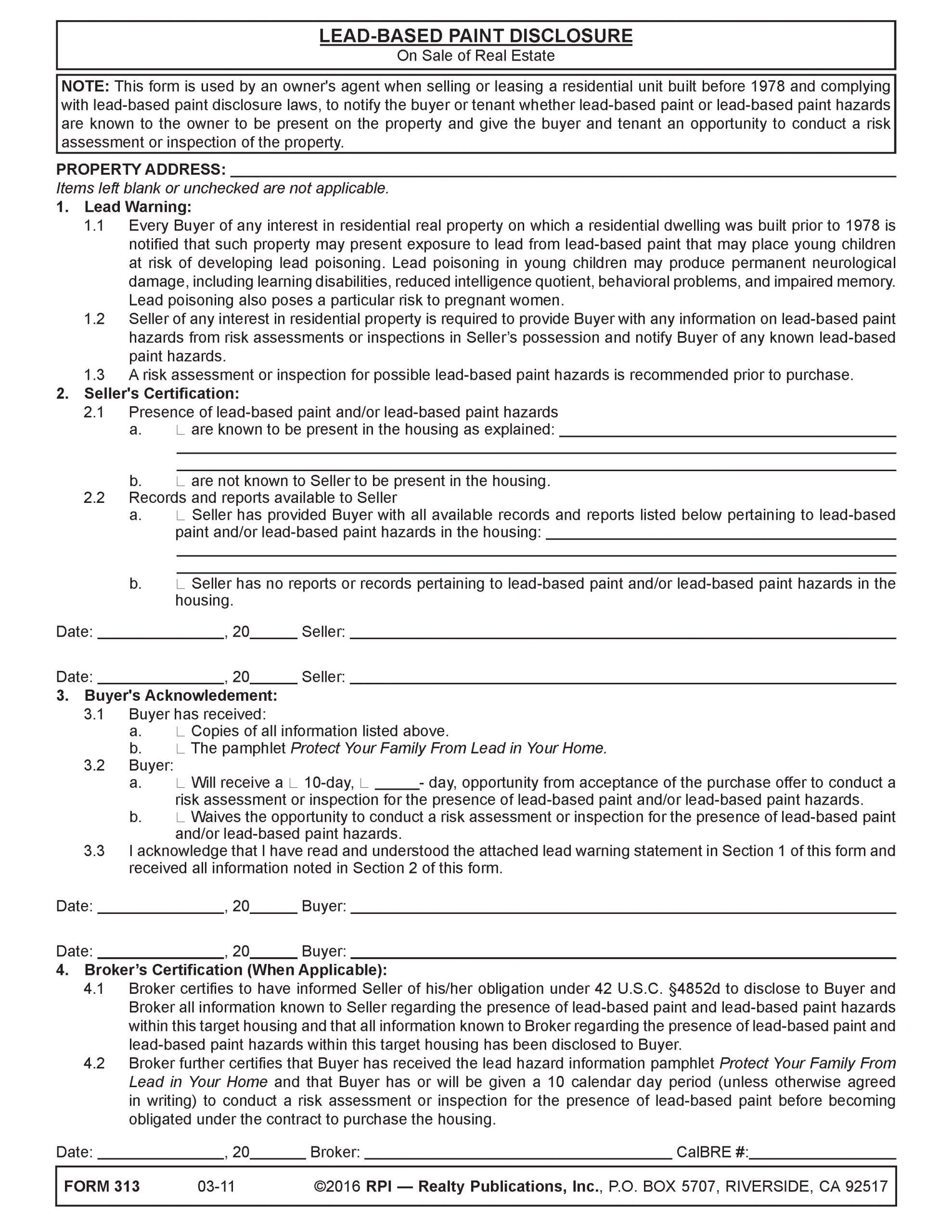This form is used by an owner’s agent when selling or leasing a residential unit built before 1978 and complying with lead-based paint disclosure laws, to notify the buyer or tenant whether lead-based paint or lead-based paint hazards are known to the owner to be present on the property and give the buyer and tenant an opportunity to conduct a risk assessment or inspection of the property.
In 1978, the federal Consumer Product Safety Commission banned lead-based paint (LBP) from use. An LBP hazard is any condition causing human exposure to lead from lead-contaminated dust, soil or paint which has deteriorated to the point of producing adverse human health effects.
Federal LBP rules require a seller’s agent to advise the seller about what to disclose to the prospective buyers before the seller enters into a purchase agreement to sell their home.
A prospective buyer of a residence built prior to 1978 is given the disclosure form providing notice of any known LBP condition before they make an offer. [See RPI Form 313]
The LBP disclosure further advises that they have a 10-day period after their offer is accepted to evaluate the LBP risks involved. The LBP disclosure cannot be waived using an “as-is” sale provision or otherwise.
The seller is not obligated to have the property inspected or obtain a report on the presence of LBP or any LBP hazards. Additionally, it is unnecessary for the seller to perform any corrective work to clean up or even eliminate the LBP conditions, unless specified in an agreement with the buyer.
To comply with LBP disclosure requirements, the seller:
- fills out and signs the federal LBP disclosure form required on the sale of all pre-1978 residential construction; [See RPI Form 313]
- fills out and signs the TDS, which includes a questionnaire regarding environmental hazards on the property including the existence of LBP; [See RPI Form 304] and
- provides their agent with copies of any reports or documentation regarding LBP hazards on the property.
By making a fully-transparent presentation to prospective buyers before entering into a purchase agreement, a seller and their agent avoid later renegotiations due to delayed disclosures, including demands for a price reduction, renovation or cancellation.
A seller’s agent uses the Lead-Based Paint Disclosure form published by RPI when their property was built before 1978, to comply with lead-based paint disclosure laws. The disclosure notifies the buyer whether lead-based paint or lead-based paint hazards are known to the seller to be present on the property and gives the buyer an opportunity to conduct a risk assessment or inspection of the property. [See RPI Form 313]
The Lead-Based Paint Disclosure form contains:
- a lead warning, notifying prospective buyers that property built before 1978 may present an exposure to lead and this requires the seller to notify the buyer of any known LBP hazard on the premises so that the buyer may conduct a risk assessment or inspection for possible LBP hazards prior to purchase (See RPI Form 313 §1];
- a seller’s certification, in which the seller discloses whether the presence of LBP or LBP hazards are either known or unknown to the seller to exist on the property, as well as any records or reports available to the seller pertaining to LBP or LBP hazards [See RPI Form 313 §2];
- the buyer’s acknowledgement that the buyer has received copies of all records and reports mentioned in Section 2 and the pamphlet Protect Your Family From Lead in Your Home found in the Hazards Disclosure Booklet [See RPI Form 313 §3.1; See RPI Form 316-1];
- the buyer’s acknowledgement that the buyer either receives a 10-day opportunity from acceptance of the purchase offer to conduct a risk assessment or inspection for the presence of LBP or LBP hazards on the property, or alternatively, the opportunity to conduct a risk assessment is waived [See RPI Form 313 §3.2]; and
- the signatures of the seller, buyer and the seller’s agent.
Form navigation page published 06-2021.
Form last revised 2016.














